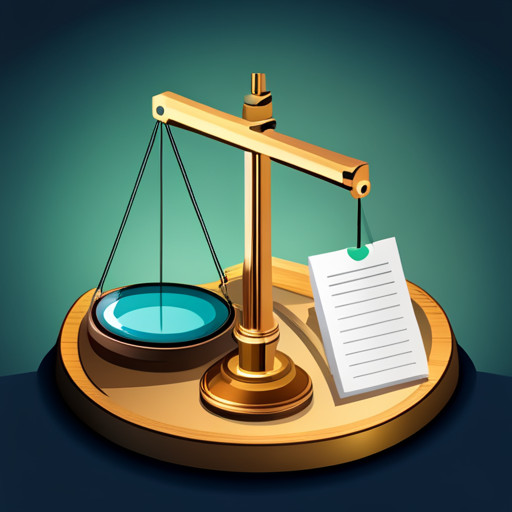Presenting Your Proof: Building a Robust Medical Evidence Portfolio
In the contemporary medical field, approximately 65% of decisions rely on robust evidence portfolios.

This article critically examines the construction and presentation of these portfolios, with emphasis on the role of medical records, diagnostic tests, expert testimonies, and ethical considerations.
The objective is to highlight strategies for effective organization and presentation, challenges encountered, and the transformative role of technology in this process.
Key Takeaways
- Medical evidence is crucial for clinical decision-making and ensuring effective and ethical healthcare.
- Building a robust medical evidence portfolio involves the use of medical records, diagnostic tests, expert testimonies, and effective organization and presentation techniques.
- Categorizing and storing medical documents, such as through document digitization and evidence authentication, is important for maintaining the integrity of the evidence.
- Understanding medical jargon, recognizing evidence bias, and considering the impact of medical research are key factors in interpreting medical evidence accurately.
Understanding Medical Evidence and Its Importance

Comprehending the nature and significance of medical evidence is key to constructing a solid evidence portfolio in the healthcare field. Medical evidence forms the bedrock of clinical decision-making processes and is integral to ensuring the delivery of effective and ethical healthcare services.
In this context, understanding evidence classification becomes a crucial step. Evidence classification refers to the systematic categorization of medical evidence based on its level of credibility and reliability. This process helps in distinguishing between high-quality, reliable evidence and low-quality, unreliable evidence. Therefore, it plays an important role in ensuring that healthcare decisions are based on the most reliable, credible, and scientifically valid evidence available.
Moreover, the incorporation of medical ethics in the management and use of medical evidence is equally important. Medical ethics encompasses principles such as autonomy, beneficence, non-maleficence, and justice. These principles guide the ethical collection, interpretation, and application of medical evidence. For instance, the principle of autonomy requires that patients' informed consent must be obtained before using their medical data as evidence. Similarly, the principle of non-maleficence mandates that the collection and use of medical evidence should not harm the patients in any way.
The Role of Medical Records in Building Your Portfolio

The role of medical records in constructing a comprehensive case file cannot be overstated, as these documents provide a verifiable trail of treatment and patient history. These records, especially when digitized into Electronic Health Records (EHRs), offer a clear, chronologically ordered, and methodical record of a patient's health journey. The process of Record Redaction further increases the value of these records by ensuring only pertinent information is presented, thus assuring confidentiality.
The importance of medical records in case building can be summarized by three key points:
- Verification of Treatment History: Medical records offer an evidence-based trail of a patient's treatment pathway. They contain information on diagnosis, prescribed treatment, and patient's response to the same.
- *Role of EHRs*: EHRs provide an easy to access, digitally stored, comprehensive record of a patient's health journey. It aids in verifying the continuity of care.
- *Impact of Record Redaction*: Record Redaction ensures that only relevant information is presented in the case file, which reduces the risk of information overload and protects patient privacy.
- Support in Legal Proceedings: Medical records serve as legal documents that can establish the nature and extent of injury or illness, and the corresponding treatment provided.
- *Role of EHRs*: With its time-stamped entries, EHRs offer undeniable proof of treatment provided at specific points in time.
- *Impact of Record Redaction*: Through careful redaction, sensitive information is concealed, protecting both the patient and the health care provider in legal proceedings.
- Assisting in Research and Policy making: These records provide invaluable data for medical research and help in shaping health policies.
- *Role of EHRs*: EHRs, with their vast data sets, are pivotal in identifying trends, planning health policies, and conducting research.
- *Impact of Record Redaction*: Redaction ensures the data used in research is anonymized, protecting patient identity while still providing valuable data.
Importance of Diagnostic Tests in Evidence Collection

Importance of diagnostic tests in the collection of evidence is underscored by their ability to provide tangible and often irrefutable data regarding a patient's health status. Such tests constitute a vital component of a robust medical evidence portfolio, facilitating the accurate diagnosis and treatment of various health conditions.
Diagnostic tests play a significant role in the medical field due to their high diagnostic accuracy. These tests are designed to detect the presence, absence, or stage of a disease with a high degree of certainty. The accuracy of a diagnostic test is determined by its sensitivity and specificity. Test sensitivity refers to a test's ability to correctly identify those with the disease, while specificity refers to the ability to correctly identify those without the disease.
The effectiveness of diagnostic tests lies in their ability to yield reliable and concrete evidence about a patient's health condition. Their importance in evidence collection extends further to tracking disease progression, assessing treatment efficacy, and monitoring patient recovery. The reliability of diagnostic tests, however, is contingent upon their diagnostic accuracy and test sensitivity.
Expert Testimonies: The Key to a Strong Portfolio

Expert testimonies hold a paramount position in creating a strong portfolio, serving as potent tools that often hold sway in legal and medical scenarios. The inclusion of these testimonies strengthens the credibility of the evidence, thereby increasing the chances of achieving a favorable outcome.
The weight of an expert testimony is significantly influenced by two key aspects: Testimony credibility and Expert qualification.
Testimony credibility
- Factual accuracy: A credible testimony is based on facts and is void of any false claims. It should be backed by adequate research and should be consistent with the rest of the evidence.
- Objectivity: The testimony should be unbiased, presenting the facts as they are without any form of distortion or manipulation. This objectivity is crucial in maintaining the integrity of the testimony.
- Transparency: The expert should disclose any potential conflicts of interest that may cast doubt on the credibility of the testimony.
Expert qualification
- Relevant expertise: The expert should possess in-depth knowledge and experience in the relevant field. This expertise must have been acquired through formal education, practical experience, or a combination of both.
- Recognition in the field: The expert should have a good reputation in their field and should be recognized by their peers for their contributions.
- Adherence to ethical standards: The expert should have a clean professional record, free from any disciplinary actions or ethical violations.
The Art of Organizing Your Medical Evidence

The categorization of medical documents serves as a fundamental aspect in the discussion surrounding the organization of medical evidence. The methodical arrangement of these materials can greatly influence the ease of accessing pertinent information.
A chronological evidence arrangement, for instance, could streamline the process of tracing a patient's medical history. This would bolster the credibility and coherence of a case.
Furthermore, the debate between digital and physical storage of medical documents introduces another layer of complexity to the discussion. This necessitates a thorough investigation of the benefits and drawbacks of each method in terms of security, accessibility, and cost.
Categorizing Medical Documents
Categorizing medical documents constitutes a crucial step in building a robust medical evidence portfolio, as it facilitates easy and efficient retrieval of information. This process involves Document Digitization and Evidence Authentication.
- Document Digitization:
- Conversion of physical documents into digital form.
- Ensures easy storage, access, and distribution.
- Promotes environmental sustainability by reducing paper usage.
- Evidence Authentication:
- Verification of the legitimacy and validity of the evidence.
- Involves checking for any alterations or manipulations.
- Crucial for maintaining the integrity of the evidence.
These steps enhance the credibility of the medical evidence portfolio, ensuring that the evidence is organized, verifiable, and easily accessible. Thus, proper categorization of medical documents is an indispensable component for an efficient and reliable medical evidence portfolio.
Chronological Evidence Arrangement
Chronological arrangement of evidentiary documents is an effective strategy that aids in presenting a clear and logical flow of information, thus enhancing comprehension and analysis. This approach, known as evidence sequencing, is critical in portfolio presentation as it provides a timeline of events, enabling reviewers to trace the progression of a case. This methodical, evidence-based approach ensures a detail-oriented presentation of facts.
The following table illustrates the importance of sequencing in a simplified medical evidence portfolio:
| Date | Document Type | Relevance |
|---|---|---|
| Jan 1, 2020 | Initial Consultation Note | Establishes baseline patient health |
| Mar 15, 2020 | Lab Results | Shows progression of disease |
| Jun 30, 2020 | Treatment Plan | Displays medical intervention |
| Dec 31, 2020 | Follow-up Consultation Note | Assesses treatment impact |
A well-sequenced portfolio provides a comprehensive view of a patient's journey, thereby enhancing the understanding of the case.
Digital Vs. Physical Storage
In the realm of evidence storage, a pivotal consideration is the choice between digital and physical mediums, each bearing distinctive advantages and potential drawbacks.
Digital storage, underpinned by digital encryption, provides:
- Enhanced security, mitigating the risk of unauthorized access or potential tampering.
- Convenience, allowing for easy searching, organization, and retrieval of files.
Physical storage, although traditional, still holds value:
- Tangibility, offering a physical presence that could be critical in legal proceedings.
- Independence from technological failure, minimizing the risk of data loss.
Cloud backup, an aspect of digital storage, offers:
- Disaster recovery, protecting against data loss due to physical damage.
- Accessibility, enabling access to data from any location with internet connectivity.
This comparison illuminates the importance of carefully considering the method of evidence storage in building a robust medical evidence portfolio.
Guidelines for Interpreting Medical Evidence

Understanding the correct interpretation of medical evidence requires a comprehensive grasp of certain fundamental guidelines. These include not only the ability to decipher complex medical jargon but also to discern potential instances of evidence bias. The latter can significantly alter the understanding of a given set of data, thereby leading to incorrect assumptions and ultimately, flawed conclusions.
Evidence bias refers to systematic errors in the way data is collected, analyzed, interpreted, or published that can lead to inaccurate results. Common types of evidence bias in medical research include selection bias, information bias, and confounding bias. Understanding these biases is critical to accurately interpreting medical evidence. For example, selection bias can occur when the sample used in a study is not representative of the population the study aims to generalize about. Such bias can significantly skew results and lead to misleading conclusions.
Medical jargon, on the other hand, is a language full of specific phrases and terminologies used exclusively within the medical community. Given its complexity, it can often pose a barrier to understanding for those unfamiliar with the field. A correct interpretation of medical evidence necessitates a proper comprehension of this specialized language. Misinterpretation of medical jargon can lead to erroneous conclusions, thus undermining the validity of the evidence.
Impact of Medical Research in Evidence Generation

After a comprehensive exploration of guidelines for interpreting medical evidence, the discourse now shifts to the pivotal role of medical research in generating such evidence. Undeniably, medical research, particularly clinical trials, has a profound impact on the growth of Evidence-Based Medicine (EBM), a medical care model that emphasizes the use of empirical evidence in the decision-making process.
Clinical trials, for instance, have a substantial impact on evidence generation in medicine by:
* Facilitating the development of novel therapies and treatment options
Through the structured process of clinical trials, potential treatment options are rigorously tested, analyzed, and compared to existing treatments. This systematic approach ensures the introduction of more effective and safer treatments in the medical world.
* Enhancing our understanding of diseases
These trials often provide new insights into the pathophysiology of diseases, thus contributing to a broader knowledge base that can influence future research directions.
* Influencing healthcare policies
Evidence gathered from clinical trials often sways healthcare policies and practices, ensuring they are rooted in empirical evidence rather than anecdotal experiences or unproven theories.
In essence, the impact of clinical trials is far-reaching, extending beyond the realm of immediate patient care to broader aspects of healthcare management and policy-making. Thus, medical research is indispensable in the pursuit of EBM, a model that underscores the necessity of reliable, scientifically sound evidence in the delivery of optimal patient care.
As such, the capacity of medical research to generate this evidence plays a critical role in enhancing healthcare outcomes on both individual and societal levels.
Role of Patient Histories and Physical Exams in Your Portfolio

The significance of patient histories in the clinical decision-making process is substantial, as they provide a comprehensive picture of the patient's health status, lifestyle, and past medical events.
Concurrently, the relevance of physical examinations must not be overlooked, as they offer vital, real-time data about the patient's current state and can reveal undiagnosed conditions.
The integration of patient histories and physical exams enhances the accuracy of diagnoses and improves patient outcomes, further establishing their indispensable role within the medical evidence portfolio.
Importance of Patient Histories
Patient histories play a vital role in building a robust medical evidence portfolio as they provide invaluable information about individual health trajectories. Such evidence, however, is not without its limitations and challenges.
- Patient confidentiality must be maintained, which can limit the extent of information that can be shared or used.
- This includes restrictions on personal identifiers, sensitive health information, and other patient-specific data.
Evidence limitations can occur due to various factors:
- Inaccurate patient recall during history taking.
- Unavailability of complete medical records.
- Biases and errors in documentation.
These factors underscore the need for meticulous record-keeping, careful patient interviewing, and strict adherence to ethical standards, to ensure the quality and integrity of the medical evidence portfolio.
Physical Exams Relevance
Conducting thorough physical examinations remains a critical practice in healthcare, offering a wealth of information that can complement patient histories and contribute to a comprehensive understanding of an individual's health status.
This process ensures the exam's authenticity while providing direct, observable facts about the patient's condition.
Physical examinations are instrumental in identifying signs and symptoms that may not be readily available through patient history alone.
Such findings, when meticulously documented, can significantly impact the portfolio of medical evidence, substantiating clinical decisions and treatment plans.
The information amassed from these examinations, when combined with a well-documented patient history, forms a robust evidence base that could potentially influence healthcare outcomes and improve patient care quality.
It underscores the relevance of physical examinations in modern healthcare practice.
Integrating Histories and Exams
Integration of detailed patient histories and comprehensive physical exams forms a pivotal base for accurate diagnoses and effective treatment plans. This approach ensures an understanding of a patient's overall health profile, facilitating the development of personalised treatment strategies.
Considerations in this integration process include:
* Patient consent: Ensuring voluntary participation is crucial. Informed consent guarantees patients' rights and autonomy are respected, fostering trust and collaboration in treatment plans.
* Evidence confidentiality: Confidentiality of the collected data is paramount. Ensuring privacy promotes patient confidence, enhancing the accuracy of information provided.
* Methodical procedures: Adherence to standardised procedures when collecting and integrating information is vital. This ensures the reliability of the data, reinforcing the credibility of the diagnosis and treatment plan.
The Process of Collecting and Validating Medical Evidence

In the realm of healthcare, the collection and validation of medical evidence necessitate a rigorous and systematic approach to ensure the reliability and credibility of the data. This process is integral to the adoption of evidence-based practice, which necessitates the use of the most reliable, up-to-date, and relevant data to inform the delivery of optimal patient care.
This process involves two key steps: Evidence Authentication and Patient Consent.
Evidence Authentication refers to the process of verifying the validity of the medical evidence collected. This is accomplished through a meticulously designed methodology that includes careful examination of the data sources, scrutiny of the data collection methods, and rigorous statistical analysis. This step is crucial to ensure that the data collected reflects the true state of the patient's health condition, devoid of any biases or errors.
Patient Consent is the second critical step in the process of collecting and validating medical evidence. It is a legal and ethical obligation of healthcare providers to obtain informed consent from patients before collecting any data for the purpose of medical research or treatment. This step ensures respect for patient autonomy, upholds the principles of transparency, and fosters trust between the patient and the healthcare provider.
The Significance of Peer-reviewed Articles in Medical Litigation

Peer-reviewed articles serve as an invaluable resource in medical litigation, providing scientifically valid and reliable evidence for legal proceedings. They offer a robust means to counteract potential litigation biases, facilitating the fair and impartial assessment of claims. These articles undergo rigorous scrutiny by experts in the field, thereby ensuring evidence authenticity.
The significance of peer-reviewed articles can be further delineated by:
Quality Assurance:
- Ensuring that the studies and their results meet the highest standards of scientific integrity.
- Providing an additional layer of scrutiny, which safeguards against potential fraud or misconduct.
Reliability:
- Enhancing the credibility of evidence presented in court.
- Offering a reliable source of information for expert witnesses.
Impartiality:
- Mitigating the risk of litigation biases by providing unbiased, objective evidence.
- Serving as a neutral ground in disputes, where personal interpretations or biases could cloud judgement.
The rigorous nature of peer-review, coupled with the high esteem with which these articles are held, contribute to their pivotal role in medical litigation. However, it is crucial to ensure that these resources are used judiciously and ethically, avoiding any potential misinterpretations or misuse of data. Furthermore, while these articles serve as strong evidence, they should not be considered infallible, but rather, one component within a comprehensive portfolio of evidence.
The Challenge of Incomplete or Inaccurate Medical Records

Challenges arise when dealing with incomplete or inaccurate medical records during litigation, as these can compromise the validity and reliability of presented evidence. Record Authenticity, a primary concern in these situations, refers to the genuineness and credibility of the medical records. Any inconsistencies or inaccuracies can question the authenticity of the records, leading to potential disputes during litigation.
Interpretation Errors constitute another significant issue with incomplete or inaccurate medical records. Misinterpretation or misunderstanding of medical terminology, abbreviations, or handwriting can result in critical errors affecting the outcome of the case.
The markdown table below provides a systematic breakdown of these challenges, their potential causes, and their potential impacts on litigation.
| Challenges | Potential Causes | Potential Impact on Litigation |
| Record Authenticity | Inconsistencies, inaccuracies, alterations | Disputes over credibility, validity of evidence |
| Interpretation Errors | Misunderstanding of terminology, abbreviations, or handwriting | Incorrect conclusions, misguided legal strategies |
| Incomplete or inaccurate records | Omissions, errors, lack of updates | Uncertainty, unreliable evidence, compromised case |
It is crucial, therefore, to employ meticulous, evidence-based strategies to ensure the reliability and credibility of medical records during litigation. The introduction of technological advancements in medical record-keeping, such as electronic health records (EHRs), has potential solutions for these challenges, by improving accuracy, completeness, and interpretability. However, even with these advancements, careful review and scrutiny of medical records remain paramount to prevent potential pitfalls in litigation.
Techniques for Presenting Your Medical Evidence Effectively

Effective demonstration of healthcare documentation in a court proceeding necessitates the utilization of specific techniques aimed at enhancing the clarity, credibility, and comprehensibility of the presented information. These techniques primarily focus on evidence persuasion and portfolio presentation, which are critical for constructing a convincing argument based on medical records.
Techniques for effective portfolio presentation and evidence persuasion are multifaceted, consisting of the following aspects:
- Preparation of Evidence:
- Thorough review and understanding of all medical records.
- Highlighting crucial findings or inconsistencies that can be used as strong evidence.
- Organizing records chronologically to demonstrate the progression of the patient's condition.
- Presentation of Evidence:
- Using visual aids such as graphs, diagrams, or timelines to enhance comprehension.
- Providing succinct summaries of complex medical records to ensure they are easily understood by non-medical personnel.
- Persuasion Techniques:
- Framing the medical evidence in a way that supports the case narrative.
- Use of expert testimonies to corroborate the evidence presented.
- Anticipating and addressing potential counterarguments or questions.
The ultimate goal of these techniques is to produce a robust medical evidence portfolio that can withstand scrutiny and successfully persuade a court. Each step in this process requires a methodical approach, careful attention to detail, and an understanding of the legal context in which the evidence will be presented.
How Technology Is Revolutionizing the Medical Evidence Portfolio

Technological advancements are significantly transforming the landscape of healthcare documentation, providing innovative avenues for the efficient organization, analysis, and presentation of medical records in legal proceedings. The advent of Artificial Intelligence (AI) applications and blockchain technology elevates the robustness and credibility of medical evidence portfolios.
The application of AI in healthcare documentation streamlines the collection, organization, and analysis of medical records. AI algorithms can process large volumes of data quickly and accurately, reducing the possibility of human error. They also have the capacity to identify patterns and trends in the data, which can provide insightful and compelling evidence in legal cases. Furthermore, AI tools can convert complex medical data into understandable and accessible formats, enhancing the clarity and effectiveness of evidence presentation.
Moreover, blockchain technology offers numerous benefits for securing and authenticating medical records. Its decentralized and immutable nature ensures that the stored data is resistant to tampering, thereby enhancing the integrity and credibility of the evidence. Blockchain technology also provides a transparent and traceable record of data transactions, which can help to establish the chain of custody of medical evidence.
Ethical Considerations When Building a Medical Evidence Portfolio

Ethical considerations play a paramount role when compiling healthcare documentation, ensuring the preservation of patient confidentiality, informed consent, and data integrity. The process necessitates an acute awareness of potential ethical dilemmas and a robust strategy to protect patient privacy.
The following points elucidate key elements in the ethical compilation of a medical evidence portfolio:
- Patient Consent:
- An essential component of ethical healthcare documentation is the procurement of informed consent from patients whose data are used.
- This process should clearly communicate the nature, purpose, benefits, and potential risks of data usage, providing patients with the autonomy to make informed decisions.
- Confidentiality and Privacy:
- Safeguarding patient privacy is a non-negotiable aspect of ethical medical documentation.
- Data anonymization strategies and robust security measures should be employed to protect patient identity and sensitive health information.
- Data Integrity and Accountability:
- Maintaining the accuracy and consistency of data is crucial in healthcare documentation.
- Regular audits, stringent data management protocols, and accountability measures can help ensure data integrity, thereby increasing the reliability and credibility of the medical evidence portfolio.
These ethical considerations underscore the importance of adhering to professional codes of conduct and legal requirements when handling patient data. Ethical dilemmas in this context may include navigating the balance between patient privacy and the need for comprehensive data. A robust ethical framework, rooted in respect for patient autonomy, privacy, and data integrity, is hence indispensable for the responsible compilation of a medical evidence portfolio.
Frequently Asked Questions
What Are Some Common Mistakes People Make When Compiling a Medical Evidence Portfolio?
Common errors in compiling a medical evidence portfolio include insufficient evidence verification and inadequate portfolio organization.
Evidence may be improperly verified, leading to the inclusion of incorrect or irrelevant information.
Additionally, disorganized portfolios may impede the clear presentation of evidence, making it difficult for reviewers to ascertain the validity and relevance of the included data.
Thus, meticulous attention to these processes is essential for the assembly of a robust and effective medical evidence portfolio.
How Can I Protect the Confidentiality and Privacy of My Medical Evidence Portfolio?
Protection of the confidentiality and privacy of a medical evidence portfolio can be achieved through various methods.
Utilization of encryption techniques ensures secure storage and transmission of data.
Additionally, acquiring patient consent before information collection and dissemination further safeguards privacy.
Ensuring strict adherence to these methods can significantly reduce potential breaches of confidentiality, thereby maintaining the integrity of the medical evidence portfolio.
Are There Any Specific Software or Tools Recommended for Creating a Comprehensive Medical Evidence Portfolio?
In the pursuit of creating a comprehensive medical evidence portfolio, specific software tools can indeed facilitate the process. Employing Portfolio Organization Strategies and Evidence Validation Techniques, these tools aid in the systematic arrangement and validation of medical evidence.
While a range of software exists, the choice largely depends on the specific requirements, such as ease of use, security features, and ability to handle large data sets. It is imperative to consider these factors while selecting a software tool for creating a robust portfolio.
Can a Patient’s Family History Contribute to the Medical Evidence Portfolio?
Indeed, a patient's family history can significantly contribute to a medical evidence portfolio. Genetic implications often reveal predispositions to certain diseases, thereby influencing preventative and treatment strategies.
Ancestral health patterns, particularly those that display patterns of disease, can offer valuable insights into a patient's health risks. Therefore, the integration of family history into the portfolio can enhance the accuracy and comprehensiveness of the medical evidence collected.
How to Handle Any Potential Bias or Conflicts of Interest When Using Expert Testimonies?
Addressing potential bias or conflicts of interest in expert testimonies requires rigorous Expert Credibility Evaluation. This involves scrutinising the expert's background, potential affiliations, and previous testimonies for signs of bias.
Bias Identification Techniques, such as examining for consistency in testimonies across similar cases and checking for financial ties to interested parties, are pivotal.
This systematic approach ensures the credibility and objectivity of expert testimonies, thereby enhancing the integrity of the evidence presented.
Conclusion
In conclusion, the construction of a robust medical evidence portfolio demands meticulous organization, rigorous ethical standards, and the strategic use of technology.
With 80% of serious medical errors resulting from miscommunication during transitions of care, according to the Joint Commission, the importance of comprehensive and accurate medical records becomes clear.
The effective presentation of this evidence, supported by expert testimonies and diagnostic tests, is key to the advancement of medical research and patient care.

This post has been generated by AI and was not reviewed by editors. This is Not legal advice. Please consult with an attorney.




